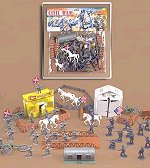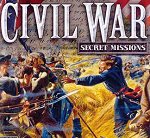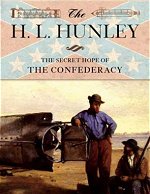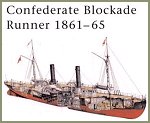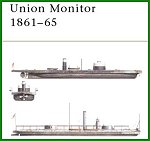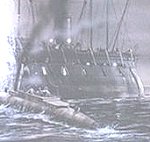Dacotah
A steam sloop, was launched 23 March 1859 by Norfolk Navy Yard and commissioned 1 May 1860, Commander W. Radford in command.
Sailing from Norfolk 30 June 1860 Dacotah rounded the Cape of Good Hope, and arrived at Hong Kong 8 January 1861 to join the East Indian Squadron. She cruised off China until returning to Hong Kong on 14 June. On 6 August she sailed for home and arrived at St. Thomas, Virgin Islands, 21 November for 2 weeks of patrolling before arriving at New York 20 December.
Out of commission from 31 December 1861 to 25 February 1862, Dacotah sailed on 9 March to join the North Atlantic Blockading Squadron. She served in the waters around Hampton Roads from 13 March to 14 September except for a cruise to New Orleans in May and June to carry messages to Flag Officer D. G. Parragut. Prom 19 July she was assigned to the James River Flotilla. She had several skirmishes with the Confederates including those in which a company of her sailors and marines, destroyed a Confederate battery of 11 guns at Harden's Bluff, Va., on 2 July, and one of 15 guns at Day's Point, Va., the next day.
Ordered to Nassau 4 September 1862 to search for the Confederate privateers Alabama and Florida, she patrolled off the Bahamas until 1 November when she was sent to search further northward to Newfoundland and Nova Scotia. She joined the blockading forces off Wilmington, N.C., on 8 December and served there until 11 June 1863 when she stood out for Baltimore, Md., and repairs to her boilers. Returning to the blockade 15 September she was ordered into quarantine at New York the next month when several cases of smallpox were discovered on board. During a repair period at Portsmouth, N.H., she participated in the search for the captured steamer Chesapeake, turned raider, from 13 to 23 December.
Decotah departed Portsmouth 28 January 1864 to rejoin the North Atlantic Blockading Squadron at Beaufort, N.C., serving' there until 2 August when she sailed for Boston Navy Yard and overhaul. Out of commission from 19 August 1864 to 29 May 1865 she cruised in the West Indies from 13 June 1865 until her arrival at Philadelphia Navy Yard 31 August.
Dacotah put to sea from Philadelphia 27 January 1866 for a voyage to the Pacific, calling at Funchal, Maderia, Rio de Janeiro, Montevideo, and after passing through the Straits of Magellan, at Valparaiso. Following duty off the coasts of South and Central America, Mexico, and California until 26 July 1869, Dacotah remained in an inactive status until sold 30 May 1873 at Mare Island Navy Yard.

Union River Ironclad 1861-65
At the start of the American Civil War, neither side had warships on the Mississippi River. In what would prove the vital naval campaign of the war, both sides fought for control of the river. While the Confederates relied on field fortifications and small gunboats, the Union built a series of revolutionary river ironclads


